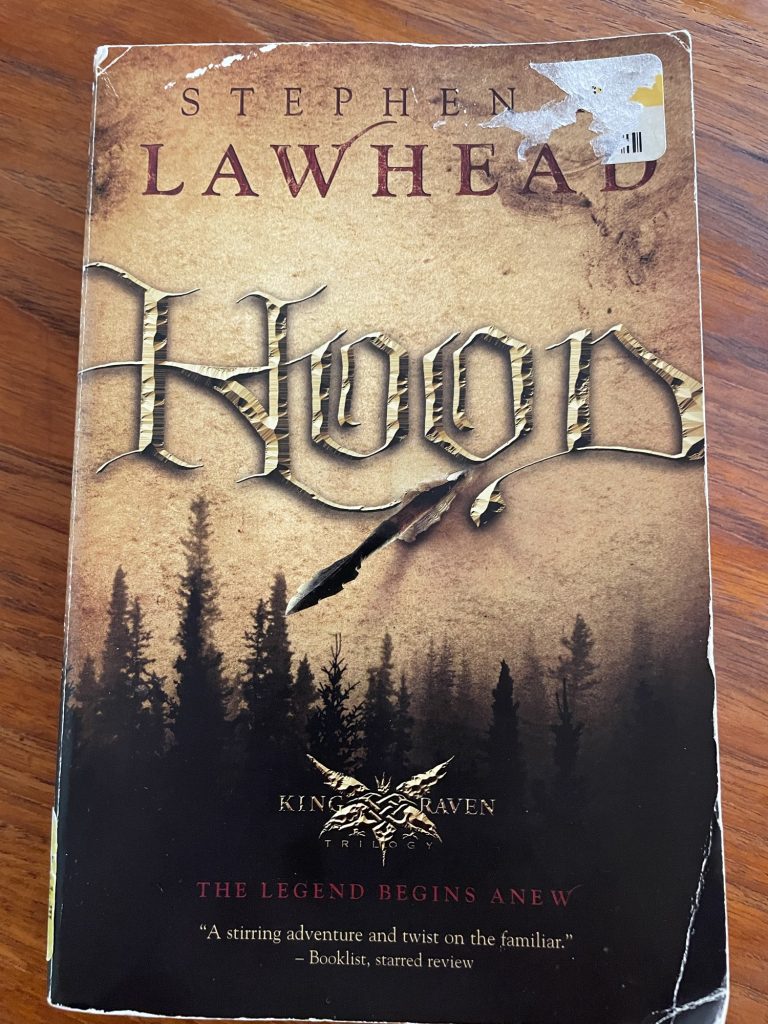Posts Tagged ‘Stephen Lawhead’
HOOD, by Stephen Lawhead, A No-Spoiler Review
Last fall, I needed to restock my Little Free Library, so headed to the local Goodwill to see what sci-fi, fantasy or dystopian fiction they had on hand. (My LFLibrary is filled with these genres only). I did find some great treasures, including this Stephen Lawhead book that I had never heard of. I began reading it sometime in the winter and got hooked. I knew of Lawhead because of reading the Pendragon Cycle sometime in my 20s. HOOD is book one in the King Raven Trilogy.
HOOD is the first book in a trilogy that follows a character based on the Robin Hood myth/legend.
Short Review of HOOD
I highly recommend this novel. Here’s why:
- Stephen Lawhead (author of The Pendragon Cycle…a version of the Arthurian Legend) is an accomplished writer who knows how to capture the voice of medieval and pre-medieval Brits.
- His world-building feels rooted in history, authentic
- The language engages…everything from the quirky colloquialisms, to the names of characters
- The characters are well developed, even the evil ones, and draw you into their world of struggle and heroism
- Woven into the story are Christian themes and prayers, which some won’t like, but I absorbed as authentic
- Rated PG (for medieval violence, think swords and bow and arrow…but no graphic sex or sexual violence)

The Longer Review:
If you’re reading this novel, I recommend flipping to the back of the book and reading his essay: Robin Hood in Wales? It’s past the epilogue (don’t read the epilogue or you will spoil the story).
In this essay, Lawhead discusses why he sets HOOD in Wales, playing with the idea that the legend of Robin Hood had been around and circulating through the British Isles for a very long time before the general population associated him with Sherwood Forest. Here is a bit of that essay:
It will seem strange to many readers, and perhaps even perverse, to take Robin Hood out of Sherwood Forest and relocate him in Wales; worse still to remove all trace of Englishness, set his story in the eleventh century, and recast the honourable outlaw as an early British freedom fighter. My contention is that although in Nottingham, the Robin Hood legends found good soil in which to grow, they must surely have originated elsewhere.
The character we now know as Robin Hood can be traced as far back as the early 1260s. By 1350, the Robin Hood legends were well-known, if somewhat various, consisting of a loose aggregation of poems and songs plied by the troubadours and minstrels of the day. These poems and songs bore little relation to one another. The first written references to and carried titles such as “Robin Hood and the Potter,” “Robin Hood’s Chase,” “Robin Hood and the Bishop of Hereford,” “the Jolly Pinder of Wakefield,” The “Noble Fisherman,” “Robins Whood Turned Hermit”…
So, Lawhead poses the possibility that Robin Hood (or Rhi Bran Hud, as he is called by his Norman enemies) is a deposed Prince/King who is rallying his people to push back against the Norman Invasion? He fights a guerilla war with long bows and hides in the wild forests of the March, attacking and tormenting the French who cannot defeat this clever and courageous rival.
A comment about the Christian themes in this novel. The church and state are intermingled throughout Europe during this time in history. The Norman Kings are closely aligned with church. In 800 CE, Charlamagne is crowned by the pope as the Holy Roman Emperor. Kings are seen and dubbed as God’s holy vessels to lead the people. The church holds much power in this system and therefore becomes the vehicle for distributing blessing but also horrible injustice. Lawhead has been careful to look at source material as he weaves church and state together in his books. He also doesn’t sugarcoat the evil that was perpetrated by the church.
If you can enter into the world Lawhead has created and withhold judgment, realizing how different most of Europe was from the Post-Modern West, you can begin to understand something of the mindset of those who lived in this time period. Why did kings, for example, pay the church from their own treasury to atone for their sin of killing enemy soldiers and potentially damning them to hell? Why did priests go out with fighters to give them last rites before a battle? Reading Lawhead will put some of these questions into context. The link between the church and the king cannot be understated in a book that is attempting to portray authentic medieval culture.
Therefore, when I read HOOD I felt like I was reading historical fiction. It’s a kind of escape into fantasy, but not quite. Lawhead is so fluent in the language and history of this time period in Britain, that he transported me back a thousand years. This is an aspect of world-building that felt extremely enjoyable to me, which is why I recommend this book to readers of all ages.